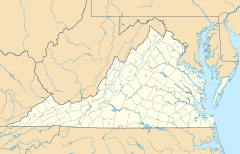Cherry Orchard Bog Natural Area Preserve facts for kids
Quick facts for kids Cherry Orchard Bog Natural Area Preserve |
|
|---|---|
| Location | Sussex and Prince George counties, Virginia |
| Nearest city | Templeton, Virginia |
| Area | 354 acres (143 ha) |
| Governing body | Virginia Department of Conservation and Recreation |
The Cherry Orchard Bog Natural Area Preserve is a special natural space in Virginia. It covers about 354 acres (143 hectares) of land. You can find it in Sussex and Prince George counties. This preserve is part of the Virginia Natural Area Preserve System, which protects important natural areas.
The Virginia Department of Conservation and Recreation (DCR) owns and takes care of this preserve. It is not set up for regular public visits. If you want to visit, you need to arrange it with a DCR land manager first. The preserve is located near a power line path. This area gets water that is a bit acidic and low in nutrients.
Contents
Amazing Plants and How They Are Protected
This preserve is home to a unique type of wetland called a seepage wetland. This means water slowly seeps out of the ground. This special environment helps many rare plants grow here.
Rare Plants You Might Find
Some of the unusual plants living in Cherry Orchard Bog include:
- Camass
- Bog-buttons
- Fringed orchids
- Purple pitcher plants (which are carnivorous plants!)
How Nature Helps These Plants
In the past, natural fires often helped these plants thrive. These fires kept woody plants from taking over the area. This allowed the rare plants to get enough sunlight and space.
Protecting the Preserve with Fire
Since the year 2000, the DCR has used a method called prescribed fire. This means they carefully set small, controlled fires. These fires help to expand and maintain the habitat for the rare plants. These plants actually need fire to grow well.
Bringing Back Longleaf Pines
In 2014, the DCR started a project to restore longleaf pines at the preserve. They used a few methods to do this:
- Removing some trees
- Using prescribed burning
- Planting new trees
Thanks to their efforts, over 50 acres of land have been restored. This land used to be covered by loblolly pine plantations. Now, it is becoming a healthy young longleaf pine community again.


